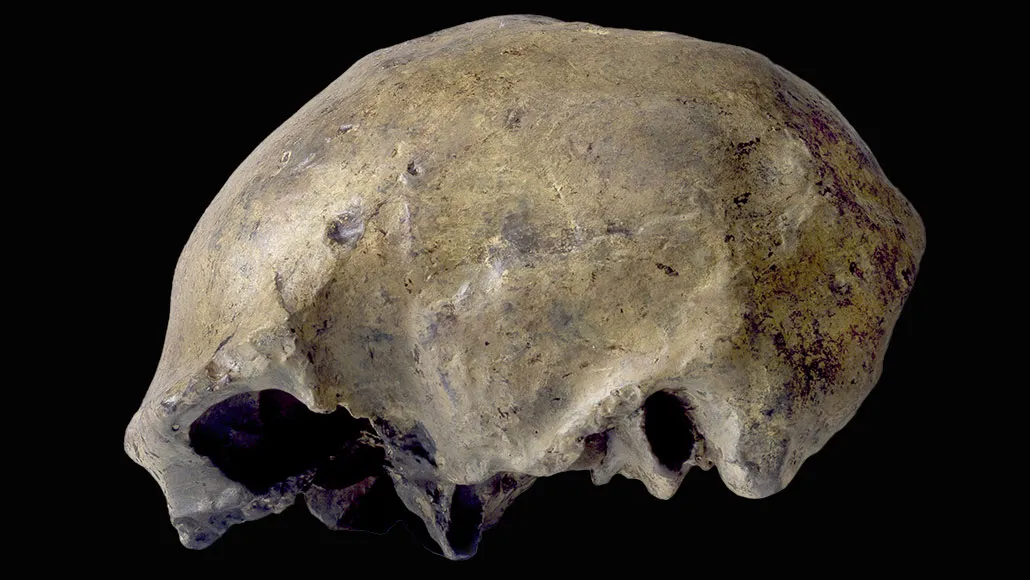Homo erectus’ last known appearance dates to roughly 117,000 years ago
New evidence helps resolve a debate over how long ago the hominid survived in what’s now Indonesia

A new study finds that the last known appearance of Homo erectus, at Java’s Ngandong site, dates to between 117,000 and 108,000 years ago. A H. erectus skullcap previously found at the site is shown.
The Natural History Museum/Alamy Stock Photo
Homo erectus, a humanlike species that dispersed from Africa into parts of Europe and Asia roughly 2 million years ago, eventually reached the Indonesian island of Java before dying out. Scientists say they have now resolved a controversy over just how long ago the last known H. erectus inhabited the Southeast Asian island.
New evidence narrows the timing of this hominid’s final stand on Java to between 117,000 and 108,000 years ago, says a team led by geochronologists Yan Rizal of Indonesia’s Bandung Institute of Technology and Kira Westaway of Macquarie University in Sydney. The scientists present their results December 18 in Nature.
If the findings hold up to scrutiny, the fossils would be the last known occurrence of H. erectus anywhere in the world, and would show that the hominid was part of a complex interplay among different Homo species in Southeast Asia that started more than 100,000 years ago.
Excavations at Java’s Ngandong site from 1931 to 1933 uncovered 12 skullcaps and two lower leg bones from H. erectus. Since then, uncertainty about how Ngandong sediment layers formed and confusion about the original location of the excavated fossils has led to dramatically contrasting age estimates for the finds.
A 1996 report in Science dated the Ngandong specimens to between 53,000 and 27,000 years ago, suggesting that H. erectus had lived alongside Homo sapiens in Indonesia (SN: 12/14/96). But a more recent analysis greatly increased the estimated age of the Java fossils, dating them to around 550,000 years ago (SN: 4/16/10).
In the new study, researchers uncovered the spot where H. erectus fossils had been found, and then excavated and dated nonhuman animal fossils from the site, including large, hoofed creatures related to water buffalo. Those estimates relied on measures of radioactive uranium decay in bones and of tooth enamel damage from natural radioactivity in the soil and from cosmic rays, energetic particles from space that continually bombard Earth.
Dates of sediment above and below the fossil site, and of a nearby mountain formation that created those deposits, aligned with the new age estimate for H. erectus.
Evidence of humans in Indonesia extends no earlier than 73,000 years ago (SN: 8/9/17). H. erectus last existed on Java at least 35,000 years before that, meaning it’s unlikely the two overlapped, says study coauthor Russell Ciochon, a paleoanthropologist at the University of Iowa in Iowa City.
Previous research indicates that H. erectus arrived on Java by about 1.6 million years ago, Ciochon says. It’s possible that Homo floresiensis, controversial half-sized hominids nicknamed hobbits, and recently reported Homo luzonensis in the Philippines evolved from H. erectus, he speculates. Hobbit and H. luzonensis fossils display some traits like those of H. erectus. Evidence suggests that H. luzonensislived on the island of Luzon at least 50,000 years ago (SN: 4/10/19), around the same time that H. floresiensis inhabited the Indonesian island of Flores (SN: 6/8/16).
Considering uncertainties in assigning precise ages to the Ngandong fossils, H. erectus may have lived there 10,000 to 20,000 years earlier or later than estimated in the new report, says paleoanthropologist Susan Antón of New York University, who was not involved in the new study. Even so, it’s still clear that humans and H. erectus didn’t overlap on Java, she says.
The new timeline supports, at a minimum, a scenario in which at least three now-extinct Homo species inhabited parts of Southeast Asia when H. sapiens was making early moves out of Africa, says paleoanthropologist Matthew Tocheri of Lakehead University in Thunder Bay, Canada. Tocheri also did not take part in the new research.
“Now we just need to figure out what exactly happened when Homo sapiens first arrived in Southeast Asia,” says Tocheri.







